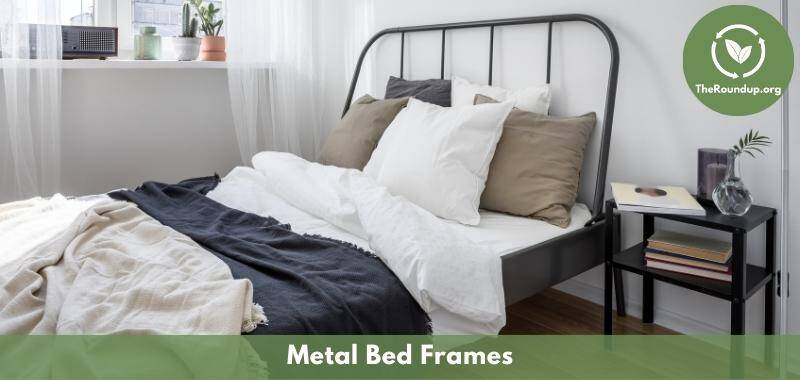
There’s a lot of debate regarding metal and wooden bed frames. But which option is best - both for your sleep, and for the environment?
Many people swear by the sturdiness and longevity of metal bed frames, while others find them cold and uninviting.
Wooden bed frames, on the other hand, are often considered warmer and inviting but can be susceptible to warping and other damage.
So, which is right for you? Where do you stand on the metal vs. wooden bed frame debate?
Not quite sure? Then you’ve come to the right place.
In this article, I’ll discuss the pros and cons of each type of bed frame so that you can make an informed decision as to which one is right for you.
Contents

Metal bed frames tend to be lighter than wooden ones. Making them easier to move around the home or transport to a new home.
Another advantage of metal bed frames is that they tend to last longer than wooden ones.
Unlike wood, they’re less likely to warp, bow, or buckle over time.
However, saying that, a large solid wood bed is unlikely to warp and will last decades. It’s the cheap thin wooden bed frames that have longevity issues.
Also, the welding joints of metal beds can be a potential weak point because they can potentially break or bend.
One significant advantage of metal bed frames is that they’re low maintenance.
As long as you keep them clean and dry (to avoid rusting), there’s not much else you need to do to maintain a metal bed frame.
You’ll also never need to treat it for termites or other wood-munching critters.
Metal bed frames are also often more adjustable than wooden ones. You can usually change the height of the bed and/or the headboard and footboard to better suit your needs.
Metal bed frames are often cheaper than their wooden frame counterparts.
Many metal bed frames can feel cold and uninviting. This is because they don’t have the same natural warmth as wooden frames.
Another downside of metal beds is that they can be noisy. The metal can creak and squeak when you move around on the bed.
Adding Loctite to squeaky joints and welds sometimes helps reduce this issue.
As mentioned earlier, metal is low maintenance, but you need to keep an eye out for rust. A rusting bed frame will eventually lose its structural integrity and collapse.
Keeping a metal bed frame dry and away from the elements is key to preventing rust.
While some metal beds are designed to look sleek and modern, they’re not usually as stylish as well-crafted or handmade artisan wood frames.
Some believe metal frames can cause electrical pollution or electromagnetic fields (EMF) in your bedroom. This is because they conduct electricity, which can disturb the natural energy field.
Reported symptoms of electrical pollution include:
If you’re worried about electrical pollution, you can buy a non-conductive metal bed frame or put a layer of insulation between the frame and your mattress. Or simply switch to wooden beds.
Many metal frames don’t have enough support for the mattress, leading to an uncomfortable sleep that might cause back problems.
One advantage of wooden frames is that they have a natural warmth to them.
Another advantage of wooden bed frames is that they often feel more inviting than metal ones. The natural warmth mentioned above gives them a softer and more homely appearance.
Both metal and wood are strong and sturdy materials. However, in the context of use as a bed frame, I feel wood has the edge in the sturdy stakes.
Wooden bed frames often have thicker legs and more support for the mattress.
Wooden bed frames often come with storage drawers underneath. This is less common with metal frames.
However, if you have no integrated storage under your bed, you can always invest in under-bed storage containers.
When it comes to bed frames, you want to avoid fads and trends that will quickly look outdated and need replacing.
A classic wood bed frame will never go out of style.
One downside of wood bed frames is that they’re more susceptible to damage than metal ones. This is because they can warp and break over time if not cared for properly.
Wood bed frames are also more likely to scratch and dent than metal ones.
Another downside of wood bed frames is that they tend to be heavier than metal ones.
Bed frames made from solid wood are usually more expensive than metal ones. Or at least the ones worth having are (most cheap wood bed frames have longevity issues).
Unless treated with potentially toxic flame retardant chemicals, a wood bed frame will burn much more quickly than a metal one.
Wood is a natural product and can sometimes stretch and sag over time. This could lead to support slats of some cheaper models not being as supportive as you would like after a few years.
Many different types of wood are used to make bed frames. My favorites are:
Many wooden bed frames use unsustainable wood.
Whatever wood type you go for, ensure it’s sustainably sourced.
Buying solid wood bed frames certified by the Forest Stewardship Council (FSC) is an excellent place to start.
As well as our personal comfort, we also need to consider whether our choices are good or bad for the environment.
Wooden bed frames are made from a natural product, so are clearly more eco-friendly than bed frames made from metal frames, right?!
It’s not quite that simple.
Some metal frames also have excellent eco-credentials (ones made from recycled or upcycled metal, for example).
My guide to sustainable wooden bed frames covers this in more detail and also contains a rundown on which wood bed frame materials are the most environmentally friendly.
You'll also learn which other materials to look for, and which to avoid.
Whether you go for metal or wood for your new bed frame, you also need to consider how the disposal of your old bed frame affects the planet.
You'll find some excellent tips on that very subject in this guide to disposing of a Bed Frame responsibly.
You can use some metal bed frames without a box spring, but it’s not always recommended.
Box springs help to distribute weight evenly and keep the mattress in good shape. The mattress will not last as long without a box spring and could sag over time.
Some metal bed frames have holes already drilled in the frame.
These holes are used to attach a headboard or footboard. If your frame does not have these holes, you can always carefully drill them yourself.
Metal bed frames are better for heavier people as they can support more weight.
However, large study wood bed frames can also support a lot of weight. They just weigh more themselves and cost more to buy.
Metal bed frames are often easier to clean since they have no nooks or crannies for dust and dirt to accumulate.
If you suffer from allergies, make sure to vacuum both your mattress and bed frame regularly.
The support afforded by your bed frame can play just as important a role in helping you get a good night’s sleep as your mattress, so this is not an area to penny pinch.
Yes, shop around for discounts, etc., but I would ultimately advise buying the best quality bed frame you can afford.
There are numerous reasons why it’s beneficial to have your mattress on a bed frame rather than simply on the floor, such as:
So, there you have it…the pros and cons of metal vs. wooden bed frames.
I hope this article has helped you decide which one is right for you.
My feelings on the subject revolve around price and longevity.
One of the cornerstones of sustainability is buying products that will last a long time. You don’t want to waste money and natural resources purchasing a new bed frame every few years.
So, with that in mind, if you have a small budget, I think a metal frame would be best.
But if your budget is more generous, then investing in a solid wood bed frame will pay you back with decades of faithful service.
Do you sleep on a metal or wood bed?
Do you prefer the affordability of a metal frame? Or is the natural warmth and inviting appearance of a wood frame more your style? Drop me a line and let me know.

